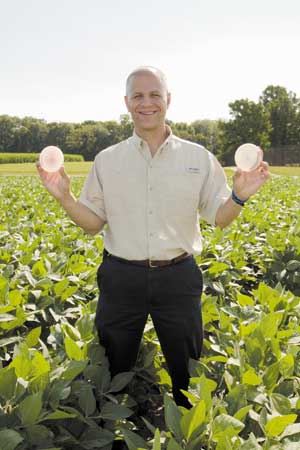|
Good/Bad Organisms
Study Looks Inside Plant Roots For Clues About Plant Health
BETTY VALLE GEGG-NAEGER
MidAmerica Farmer Grower
BELLEVILLE, ILL.
Seedling pathogens and organisms inside the roots of plants that are now causing disease were discussed at the Belleville Field Day by Dr. Jason Bond, plant pathologist at Southern Illinois University.
“The Soil-borne Organisms: The Good, The Bad, And The Ugly,” title of his talk, is also a good description of what’s occurring in soils across the country.
“We have both a mixture of the organisms that are harmful to plants, but also some that keep those harmful organisms in check,” he explained. “One project we have at Southern Illinois University is funded by The United Soybean Board and also the North Central Soybean Research Program, two checkoff organizations that administer the funds for research.”
SIU coordinates this project, focusing on many objectives. One objective which Bond discussed is a survey of these organisms that are being found in the roots of diseased plants.
“We had 10 states that sent in samples that were collected across their states and then we identified all the organisms that were in those roots,” he continued. “We found some of the common culprits that you would expect, a lot of the fusarium species, rhizoctonia that so much is known about, but we also found a lot of organisms that have never been reported in soybean roots. These organisms were in the roots, but we don’t know what role they had with regard to plant health.

Dr. Jason Bond, plant pathologist
at Southern Illinois University spoke
recently of organisms that are harmful
to plants and some that keep the
harmful organisms in check.
Photo by John LaRose, Jr.
“So now we will test those organisms to determine if they are also pathogens or whether they’re taking up a small niche that one of these harmful organisms would want to take up inside those plants,” Bond explained. “That was one of the neat aspects of the project.”
The study also focused on the genus fusarium. Much is known about fusarium, it’s a major generator of plant diseases. There are many, many species of fusarium. Almost every crop grown has a fusarium species that can attack it.
“We just came out of the wheat season where we had a lot of head scab, that is a fusarium species as well,” he added. “The fusarium that we focus on are those that are in the soil. This group of pathogens attacks both corn and soybean, and we found some inside of the soybean plant that we normally don’t find in soybean. A lot of them are big problems in corn. So presumably, they’re hitching a ride on the soybean plants in the years when there’s no corn in the field, but they also may be causing impact on the soybean health. So we will investigate that further with some follow up studies.”
Another aspect that Bond spoke about is the pathogen called sudden death syndrome. That disease first appears in fields about the R2 to R3 growth stage, or from early July through August. That’s when it will be popping up in most fields. It is also caused by a fusarium species that attacks the plants after emergence, soon or close to emergence; it then colonizes the root system, produces a toxin that gets translocated up into the plants and causes the syndrome’s name, which is sudden death. There’s a scorching of the leaves that occurs when it’s going through the reproductive stages of the plant,” he said.
“One reason I’m touching on that is because we’ve had fairly normal planting dates this year; in some cases people planted their soybean crops fairly early. That promotes the disease.”
Very good growing conditions, something that drives high yield, also drives the incidence and severity of sudden death syndrome.
“Earlier this year I visited a farm north of Albers, Ill., that already exhibited sudden death syndrome,” Bond explained. “It was planted May 20, not extremely early in terms of soybean planting dates, but he used a very susceptible variety and some of the plants even were dying. That’s not the normal type symptom that we see in plants but what that’s showing is this field has a very intense disease environment for this year and probably for the future.
“I liken those fields to be like a sentinel field or sentinel plot, and it tells us we’re probably going to have a lot of SDS across this state and anywhere we’ve had reasonable planting conditions and also plenty of rainfall,” he said. “So as we go farther north in Illinois up into Iowa they’ve had all the conditions that are needed to have high SDS this year.”
The sad thing is, nothing can be done this year to help plants that are exhibiting this disease.
“We can make note of those varieties and not plant them in the future; the best way we can manage sudden death syndrome is with variety selection,” Bond said. ∆
BETTY VALLE GEGG-NAEGER: Senior Staff Writer, MidAmerica Farmer Grower
|
|